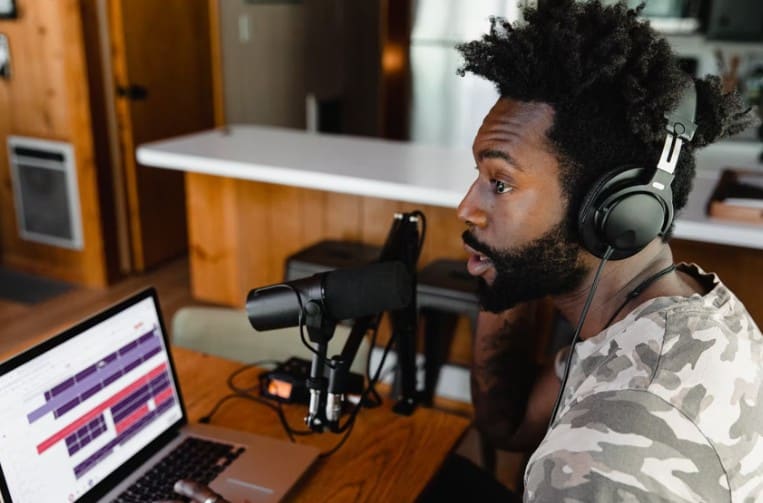Here is what you need to know when starting a podcast site in 2023

Introduction
Podcasting is the creation and distribution of audio or video content over the internet. Here is what you need to know when starting a podcast. Podcasts are typically delivered as a series of episodes that can be subscribed to and listened to or watched at any time. The term “podcast” was first coined in 2004 and has since become a popular form of media, with millions of people tuning in to listen to podcasts every day.
Podcasting has experienced significant growth in recent years, with more and more people turning to podcasts for entertainment, education, and information. According to recent studies, the number of people who listen to podcasts on a monthly basis has increased dramatically, and this trend is expected to continue. The versatility and convenience of podcasts make them an attractive form of media for people of all ages and interests.
The purpose of this guide is to provide a comprehensive overview of the key steps and considerations for starting a podcast in 2023. Whether you are a seasoned podcaster or a beginner, this guide will provide you with the podcast tools and resources you need to build a successful and enjoyable podcast that reaches a wide audience and makes a positive impact.
Equipment and Technical Requirements
A. Microphone The microphone is one of the most important pieces of equipment for podcasting. A good microphone will ensure that your audio quality is clear and professional. There are many options to choose from, including USB microphones, XLR microphones, and lavalier microphones. Consider your budget and the type of content you will be producing when selecting a microphone.
B. Recording software Recording software is used to capture and edit your podcast audio. There are many options to choose from, including free and paid software. Consider the features you need and your budget when selecting a recording software. Some popular options include Audacity, GarageBand, and Adobe Audition.
C. Hosting platform A hosting platform is where your podcast is stored and distributed. There are many hosting platforms to choose from, including free and paid options. Consider the features you need, such as analytics and monetization, and your budget when selecting a hosting platform. Some popular options include Anchor, Buzzsprout, and Libsyn.
D. Soundproofing Soundproofing is important for ensuring that your podcast audio is of high quality. There are many options for soundproofing, including foam panels, soundproof curtains, and dedicated soundproof recording studios. Consider your budget and the location of your recording setup when selecting a soundproofing solution.
Finding Your Niche
A. Identifying your interests and expertise The first step in finding your niche is to identify your interests and areas of expertise. Consider what you are passionate about and what you have experience or knowledge in. This will help you to find a topic that you are comfortable and confident discussing, and that will be of interest to your audience.
B. Researching your target audience Once you have identified your niche, it is important to research your target audience. Consider who your ideal listener is, what their interests and needs are, and what kind of content they are looking for. This information will help you to create content that resonates with your target audience and keeps them engaged.
C. Defining your unique value proposition Your unique value proposition is what sets your podcast apart from others in your niche. Consider what you have to offer that is unique and valuable to your target audience. This could be your unique perspective, your expertise, or your unique take on a topic. By defining your unique value proposition, you will be able to create content that is differentiated and compelling.
Creating a Podcast Name and Cover
A. Choosing a podcast name Your podcast name is one of the first things that potential listeners will see, so it is important to choose a name that is memorable, relevant, and catchy. Consider using a play on words, a pun, or a reference to your topic. It is also important to ensure that your podcast name is available as a domain name and social media handle.
B. Designing a cover art Your cover art is the visual representation of your podcast and should reflect the content and tone of your show. Your cover art should be eye-catching, professional, and easily recognizable. Consider using an illustration, a photo, or a simple graphic design that is consistent with your podcast name and topic.
Recording and Editing Your Podcast
A. Planning your content Before recording, it is important to plan your content. Consider what topics you will cover, how long each episode will be, and any guest speakers or segments you will include. Having a clear plan will help you to stay focused and ensure that your podcast is well-structured and engaging.
B. Recording your podcast When recording your podcast, it is important to have a quiet and comfortable environment. Ensure that you have all of your equipment set up and that you have tested your microphone and recording software. Start recording and speak clearly, naturally, and with enthusiasm.
C. Editing your podcast Once you have recorded your podcast, it is time to edit your audio. Use your recording software to remove any pauses, mistakes, or unwanted background noise. You may also want to add music, sound effects, or intro and outro music to your podcast.
Publishing and Distributing Your Podcast
A. Exporting and uploading your podcast Once you have finished editing your podcast, it is time to export and upload it to your hosting platform. Ensure that your podcast is in the correct format and that it meets the requirements of your hosting platform.
B. Submitting your podcast to directories Once your podcast is uploaded to your hosting platform, it is time to submit it to directories such as Apple Podcasts, Spotify, and Google Podcasts. This will help you to reach a wider audience and increase your visibility.
C. Promoting your podcast Promoting your podcast is key to building your audience and growing your show. Consider using social media, email marketing, and guest appearances on other podcasts to promote your show. You may also want to consider running ads or sponsorships to increase your reach.
Monetizing Your Podcast
A. Advertising and sponsorships Advertising and sponsorships are common ways to monetize a podcast. Consider reaching out to brands that are relevant to your niche and target audience. You can also use services such as Midroll or Advertisecast to connect with advertisers.
B. Premium content Another way to monetize your podcast is to offer premium content, such as exclusive episodes, behind-the-scenes content, or a members-only community. Consider what value you can offer to your audience and what they would be willing to pay for.
C. Products and services Consider selling products or services related to your podcast topic. This could include books, courses, or merchandise.
Conclusion
Starting a podcast is a journey that requires dedication, creativity, and hard work. By following the steps outlined in this guide, you will have the knowledge and resources necessary to create a podcast that is professional, engaging, and memorable.
Whether you’re looking to entertain, educate, or inspire, podcasting provides a platform for your voice to be heard and your message to be shared with the world. With the right tools, audience, and strategy, you can create a thriving podcast that makes a positive impact and provides a rewarding experience for you and your listeners.
So, take the leap, invest in your dream, and start your podcast today!

Aaron is an educational specialist focusing on jobs that can be performed outside of the standard office and anywhere in the world. Aaron has worked in the Real Estate industry most of his adult life in both commercial and residential. Financial Nomads was created to bring forward the best online educational courses and software reviews to help people live better lives. https://financialnomads.com

